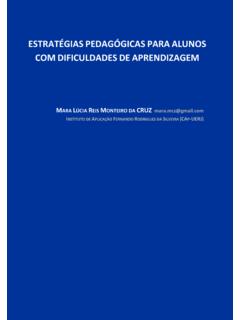Transcription of Racial Justice and Standardized Educational Testing
1 FairTest _____ National Center for Fair & Open Testing Racial Justice and Standardized Educational Testing Young people of color, particularly those from low-income families, have suffered the most as the explosion of high-stakes Standardized Testing in public education has undermined equity and school Positive assessment alternatives that will help these students and their schools do exist. They must be fought for and won in the policy arena. Decades of research demonstrate that African American, Latino and Native American students, as well as students from some Asian groups, experience the following problems with high-stakes Testing , from early childhood through college entrance: They disproportionately fail state or local high school graduation exams. Those tests provide no social or Educational benefit. They do not improve college or employment readiness.
2 Not having a diploma leads to higher rates of unemployment and imprisonment and lower rates of forming stable Students in these groups are more likely to be held back in grade because of low test scores. Grade retention produces no long-term academic benefits; it undermines self-esteem and doubles the likelihood of dropping out. Boys are subject to this damage more often than are Because, on average, students of color score lower on college admissions tests (SAT and ACT), many capable youth are denied entrance or access to so-called "merit" scholarships, contributing to the huge Racial gap in college enrollments and Schools at times suspend, expel, "counsel out" or otherwise remove students with low scores in order to boost school results and escape test-based sanctions mandated by the federal government's "No Child Left Behind" law, at great cost to the youth and ultimately As Claude Steele and his colleagues have demonstrated, "stereotype threat" increases the likelihood that students of color will have inaccurately low scores.
3 Stereotype threat means that students who are aware of Racial and gender stereotypes about their group s intellectual ability score lower on Standardized tests perceived to measure academic aptitude. In effect, the use of high-stakes Testing in an overall environment of Racial inequality perpetuates that inequality through the emotional and psychological power of the tests over the High stakes Testing causes additional damage to the many students of color who are English language learners. The tests are often inaccurate for ELLs, leading to misplacement or retention. ELLs are, alongside students with disabilities, those least likely to pass graduation African Americans, especially boys, are disproportionately placed or misplaced in special education, frequently based on test results. These programs often fail to fully educate themviii Box 300204, Jamaica Plain, MA 02108 617-477-9792 In addition to direct individual harm, high-stakes Testing is far more likely to lower the quality of curriculum, instruction and school climate in schools serving children of color: Facing high-stakes test-based accountability under NCLB and state laws, schools narrow curriculum by reducing or dropping untested subjects.
4 The law promotes teaching to the mostly multiple-choice state tests, focusing one-sidedly on rote skills and ignoring higher-level thinking. The impact is greater in schools that serve low-income youth, particularly students of Testing leads to Standardized instruction that ignores individual differences, needs and cultural variations, such as through "scripted curriculum." One size fits few, and that one size takes as its norm white, middle to upper class experiences and cultural The focus on tests and the fear that "some students" will bring down scores contributes to a stressful, often hostile school environment. This produces student behaviors that schools use to justify "zero tolerance" and other oppressive measures. Schools then unnecessarily expel or suspend students, making students more likely to drop The damage created by high-stakes Testing compounds rather than ameliorates the huge inequities caused by poverty and continuing racism.
5 However, solutions to these problems exist. Organizations and individuals must work to bring about these changes: 1. Congress must address the structural and resource inequities that plague communities with high concentrations of low-income students, most intensely those of color. This means providing adequate school resources and addressing the intertwined consequences of poverty and racism that make it very difficult for most students to reach high levels of success in school. 2. Congress must overhaul ESEA/NCLB. (The current version of NCLB is the Elementary and Secondary Education Act, ESEA.) It must end high-stakes uses of tests to evaluate schools and districts. Standardized test scores should be one minor factor in evaluating school status and Congress also must reject the Department of Education's policy of pressuring states to use test scores to evaluate teachers and principals. Tests should be only a minor factor in staff evaluations.
6 States and districts must then follow suit. 3. States and districts must end high-stakes uses of Standardized tests. No student should be held back, denied a diploma or placed in an academic track based on a test score. If used, tests should be only a minor factor, while the various tests must be 3. Colleges and universities can go test-score optional. Nearly 830 accredited, four-year institutions already have. The rest should, and graduate schools need to adopt the same 5. Congress and the states must support proven positive forms of assessment coupled with professional development that enables effective uses of such assessments. In addition, they must provide supports for ensuring schools are hospitable, engaging, supportive and academically challenging for all their References i For an extended discussion, see Neill, M.
7 2009. A Child Is Not a Test Score: Assessment as a Civil Rights Issue. 2009. Root and Branch, , Available at & branch fall - MN Testing ii FairTest. 2008. Why Graduation Tests/Exit Exams Fail to Add Value to High School Diplomas. ; FairTest. 2010. How Testing Feeds the School to Prison Pipeline. iii FairTest. Testing and Grade Retention. ; FairTest Examiner. 2006, May. Grade Retention: Still a Failed Policy. FairTest Examiner. 2008, Oct. Tests and Grade Retention. iv See materials at v Advancement Project, et al. 2010. Federal Policy, ESEA Reauthorization, and the School-to-Prison Pipeline. ,_ESEA_Reauthorization, Neill, M., Guisbond, L. & Schaeffer, B. 2004. Failing Our Children. Cambridge, MA: FairTest. Available at vi FairTest Examiner. 1995. Stereotypes Lower Test Scores. October. vii Neill, M. 2005. Assessment of ELL Students under NCLB: Problems and Solutions.
8 Viii Neill, et al. 2009. Op. cit. FairTest Examiner. 2007, Jan. NCLB Reforms for Disabled Students. ix Neill. 2009. Op cit. Neill, et al. 2004. Op cit. x Neill, et al. 2004. Op cit. xi Advancement Project, et al. 2010. Op cit. FairTest. 2010. How Testing Feeds the School to Prison Pipeline. Advancement Project (2010). Test, Punish, and Push Out: How Zero Tolerance and High-Stakes Testing Funnel Youth Into the School-to-Prison Pipeline. xii Forum on Educational Accountability, various materials at Neill, M. 2010. A Better Way to Assess Students and Evaluate Schools, Education Week, Dec. 18; available, with related material, at xiii FairTest. 2008. Why Graduation Tests/Exit Exams Fail to Add Value to High School Diplomas. xiv FairTest. 2010. Test Score Optional List. xv Forum on Educational Accountability. 2009. Empowering Schools and Improving Learning.










